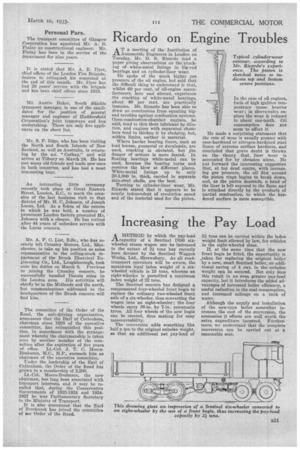Ricardo on Engine Troubles
Page 39

If you've noticed an error in this article please click here to report it so we can fix it.
AT a meeting of the Institution of Automobile Engineers in London on Tuesday, Mr. H. R. Ricardo read a paper giving observations on the cracking of white-metal linings in big-end bearings and on cylinder-liner wear.
He spoke of the much higher gas pressure of the oil engine, but said that the difficult thing to understand is that, whilst 60 per cent, of oil-engine manufacturers, here and abroad, experience the cracking of white-metal bearings, about 40 per cent. are practically immune. MT. Ricardo has been able to draw no conclusions from equating bigend troubles against combustion systems. Open-combustion-chamber engines, he said, tend to thin their lubricant by dilution, and engines with separated chambers tend to thicken it by sludging, but, within limits, neither is material.
Where harder bearing liners, such as lead bronze, gunmetal or duralumin. are used, cracking is obviated, but the danger of seizure is more feared. In floating bearings white-metal can be used, because the bearing turns andreceives the blow at different places. White-metal linings up to only 20-1,000 in. thick, carried in separate thin-steel shells, are the best.
Turning to cylinder-liner wear, Mr. Ricardo stated that it appears to be nearly independent of revolution speed and of the material used for the piston. In the case of oil engines, fuels of high ignition temperature cause heavier wear ; in sleeve-valve engines the wear is reduced to about one-tenth. Oil consumption does not seem to affect it.
He made a surprising statement that the rate of wear is usually greater with case-hardened or nitrogen-hardened steel liners of extreme surface hardness, and concluded that grave doubt is thrown on the theory that, liner wear is accounted for by abrasion alone. He put forward the interesting suggestion that, at top dead centre, with increasing gas pressure, the oil film around the piston rings begins to break down, and, as the piston descends, a band of the liner is left exposed to the flame and Is attacked directly by the products of partial combustion, to which the hardened surface is more susceptible.






































































































